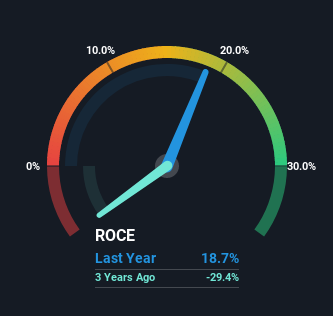- United States
- /
- General Merchandise and Department Stores
- /
- NasdaqGS:PDD
Pinduoduo's (NASDAQ:PDD) Returns On Capital Are Heading Higher

What trends should we look for it we want to identify stocks that can multiply in value over the long term? In a perfect world, we'd like to see a company investing more capital into its business and ideally the returns earned from that capital are also increasing. If you see this, it typically means it's a company with a great business model and plenty of profitable reinvestment opportunities. So on that note, Pinduoduo (NASDAQ:PDD) looks quite promising in regards to its trends of return on capital.
Return On Capital Employed (ROCE): What Is It?
For those that aren't sure what ROCE is, it measures the amount of pre-tax profits a company can generate from the capital employed in its business. To calculate this metric for Pinduoduo, this is the formula:
Return on Capital Employed = Earnings Before Interest and Tax (EBIT) ÷ (Total Assets - Current Liabilities)
0.19 = CN¥20b ÷ (CN¥192b - CN¥86b) (Based on the trailing twelve months to September 2022).
So, Pinduoduo has an ROCE of 19%. In absolute terms, that's a satisfactory return, but compared to the Online Retail industry average of 11% it's much better.
Check out the opportunities and risks within the US Online Retail industry.

Above you can see how the current ROCE for Pinduoduo compares to its prior returns on capital, but there's only so much you can tell from the past. If you'd like to see what analysts are forecasting going forward, you should check out our free report for Pinduoduo.
What Can We Tell From Pinduoduo's ROCE Trend?
Pinduoduo has recently broken into profitability so their prior investments seem to be paying off. Shareholders would no doubt be pleased with this because the business was loss-making five years ago but is is now generating 19% on its capital. In addition to that, Pinduoduo is employing 13,534% more capital than previously which is expected of a company that's trying to break into profitability. We like this trend, because it tells us the company has profitable reinvestment opportunities available to it, and if it continues going forward that can lead to a multi-bagger performance.
In another part of our analysis, we noticed that the company's ratio of current liabilities to total assets decreased to 45%, which broadly means the business is relying less on its suppliers or short-term creditors to fund its operations. So shareholders would be pleased that the growth in returns has mostly come from underlying business performance. However, current liabilities are still at a pretty high level, so just be aware that this can bring with it some risks.
The Bottom Line
Long story short, we're delighted to see that Pinduoduo's reinvestment activities have paid off and the company is now profitable. And a remarkable 105% total return over the last three years tells us that investors are expecting more good things to come in the future. With that being said, we still think the promising fundamentals mean the company deserves some further due diligence.
On a final note, we've found 1 warning sign for Pinduoduo that we think you should be aware of.
If you want to search for solid companies with great earnings, check out this free list of companies with good balance sheets and impressive returns on equity.
New: Manage All Your Stock Portfolios in One Place
We've created the ultimate portfolio companion for stock investors, and it's free.
• Connect an unlimited number of Portfolios and see your total in one currency
• Be alerted to new Warning Signs or Risks via email or mobile
• Track the Fair Value of your stocks
Have feedback on this article? Concerned about the content? Get in touch with us directly. Alternatively, email editorial-team (at) simplywallst.com.
This article by Simply Wall St is general in nature. We provide commentary based on historical data and analyst forecasts only using an unbiased methodology and our articles are not intended to be financial advice. It does not constitute a recommendation to buy or sell any stock, and does not take account of your objectives, or your financial situation. We aim to bring you long-term focused analysis driven by fundamental data. Note that our analysis may not factor in the latest price-sensitive company announcements or qualitative material. Simply Wall St has no position in any stocks mentioned.
About NasdaqGS:PDD
PDD Holdings
A multinational commerce group, owns and operates a portfolio of businesses.
Very undervalued with outstanding track record.
Similar Companies
Market Insights
Community Narratives



